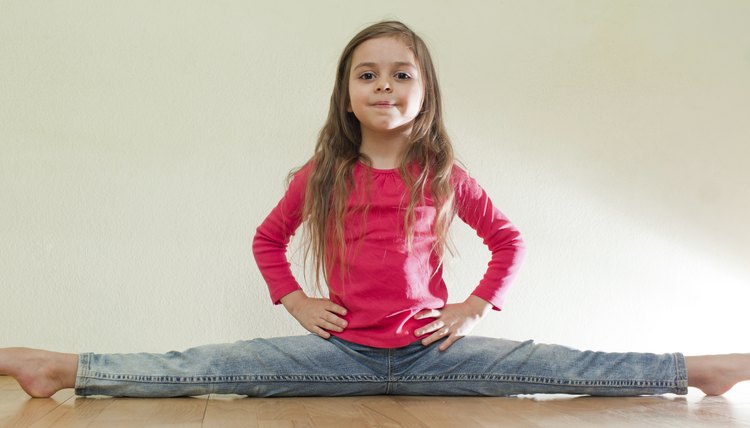How to Teach the Splits to Kids

Several factors -- including gender, age, anatomy and elasticity -- affect how quickly and easily a child will hit her splits, but careful instruction and a consistent and effective routine do play a role. Whether you're coaching a group of budding dancers or gymnasts or guiding your own precocious child, safety should be your primary consideration.
Warm them up. Instruct kids to jog back and forth across the room, join them for a game of tag or do basic calisthenics -- featuring high-knee lifts, jumping jacks and fast football runs -- for three to five minutes. Explain how vital the warm-up is, making the point that it increases blood flow, loosens the joints and prepares the muscles for stretching. Emphasize that attempting a split when the muscles are cold can cause serious damage.
Progress to dynamic stretches -- involving continuous and repetitive movement -- for the back, hips, thighs and calves. Keep it lively and fun. Together, pretend to be tin soldiers as you do straight-leg forward kicks across the room. Take long lunging steps over giant mud puddles. Do deep plie squats while holding an imaginary beach ball in front of your chest. Move to your hands and knees, and arch your back upward like a cat and then downward like an old cow.
Move on to static stretches that promote flexibility in the hip flexors, groin, hamstrings, quadriceps and calves. Demonstrate the sit-and-reach -- sitting in a pike position and hinging forward from the hips -- or a modified hurdler. Sit in the classic butterfly stretch, gently pressing your knees to the floor with your elbows. Do a basic straddle stretch, walking your fingertips slowly forward along the floor between your legs while hinging your torso forward.
Demonstrate a front split, letting kids follow your lead. From a kneeling position, hinge your torso forward slightly, place your palms on the floor and extend your right leg to the front. Using your arms to support you, push your pelvis up off the floor and carefully extend your left leg behind you. Very gradually, lower your pelvis toward the floor while keeping both legs straight, your hips and chest square to the front and your toes pointed.
Teach a middle split, instructing kids to do as you do. Start standing with your legs in a wide stance. Slowly slide your feet outward, bending your torso forward to place your palms on the floor. Keeping your legs straight and your hips facing front, continue sliding your feet outward. Lower your pelvis as much as you comfortably can while keeping your legs straight, your hips square to the front and your toes pointed.
Tips
Growth spurts can affect flexibility, because the bones tend to grow more quickly than the muscles. Advise kids to stretch carefully but consistently -- at least three times a week -- through their growth spurts to maintain flexibility.
As you demonstrate, explain that you're controlling the movement every step of the way. Emphasize that they should never drop into a split suddenly or force their bodies. Instead, they should relax, breathe normally and ease into position.
Dissuade kids from comparing themselves to their peers. Every child's range of motion is different, and it's OK if the pelvis doesn't yet reach the floor.
Warnings
Warn kids that holding any stretch -- including a split -- for too long can cause damage to connective tissues. Train kids to listen to their own bodies and notice warning signs that they're pushing too hard. If they experience any pain, pinching or popping, they should stop.
Bouncing or moving into a split too aggressively causes the muscles to tighten, which inhibits the stretch.
References
Tips
- Growth spurts can affect flexibility, because the bones tend to grow more quickly than the muscles. Advise kids to stretch carefully but consistently -- at least three times a week -- through their growth spurts to maintain flexibility.
- As you demonstrate, explain that you're controlling the movement every step of the way. Emphasize that they should never drop into a split suddenly or force their bodies. Instead, they should relax, breathe normally and ease into position.
- Dissuade kids from comparing themselves to their peers. Every child's range of motion is different, and it's OK if the pelvis doesn't yet reach the floor.
Warnings
- Warn kids that holding any stretch -- including a split -- for too long can cause damage to connective tissues. Train kids to listen to their own bodies and notice warning signs that they're pushing too hard. If they experience any pain, pinching or popping, they should stop.
- Bouncing or moving into a split too aggressively causes the muscles to tighten, which inhibits the stretch.
Writer Bio
Judy Fisk has been writing professionally since 2011, specializing in fitness, recreation, culture and the arts. A certified fitness instructor with decades of dance training, she has taught older adults, teens and kids. She has written educational and fundraising material for several non-profit organizations and her work has appeared in numerous major online publications. Fisk holds a Bachelor of Arts in public and international affairs from Princeton University.
